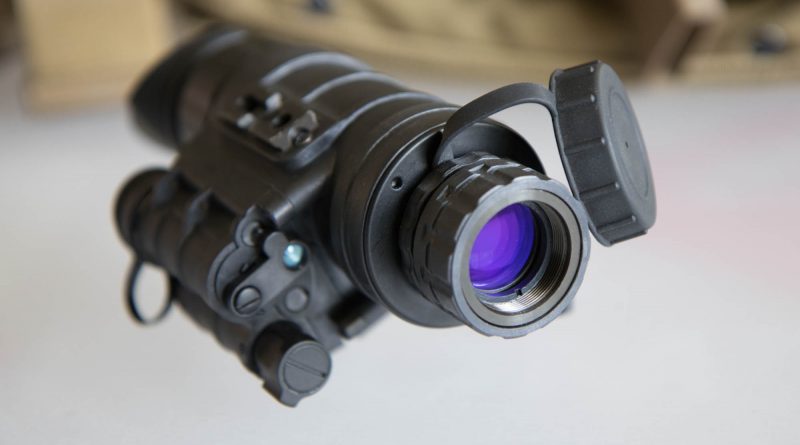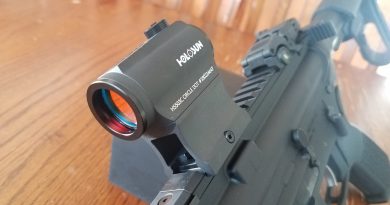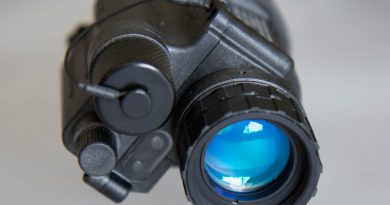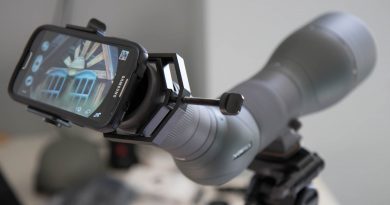Armasight Sirius Night Vision Review Gen 2+ Monocular
The Sirius ID Gen 2+ is a Night Vision Monocular marketed by Armasight (now merged with FLIR). This unit is robust, helmet, head and weapon mountable. These units are priced in the $1,700 range.
Layout and Design
This unit has a distinct rugged design motif. The body of the unit is a rugged industrial polymer most likely fiber reinforced. There are two mini rail mounting blocks. The mounts are on opposite sides so the user can determine which eye to use with the device. The On/Off switch also houses the Infra-red illuminator activation. The switch houses a safety stop so the illumination cannot be activated accidentally. The illuminator has two settings that are toggled by sliding the flood lens over the led. These two controls are on the front of the unit. The gain adjustment is on the eyepiece side of the unit next to the battery cap. there is an objective focus as well as eyepiece focus. When the IR is activated an indicator is present when looking through the device. The heft and construction of this unit feels like a tool designed for legitimate law enforcement and tactical use. When comparing this unit with the Spartan, the bulky size to weight ratio on the Spartan made it feel almost hollow and its basic plastic construction of the Spartan felt like a toy in comparison.
Sirius Capabilities for Gen 2
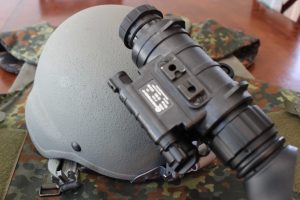
The unit is clearly intended for helmet and weapon mounting. Helmet mounting can be accomplished with FLIR’s mini-rail to bayonet adapter. Our test helmet is equipped with a Norotos mount. It has all the typical Night Vision capabilities to detect IR and detect objects in shadow better than the naked eye.
Image Quality
This unit represents a big step up from the Gen 1 unit we reviewed. The field of view is a lot bigger than the Spartan. The image quality is made better by a leap forward in light amplification. Because you can adjust the gain, you can crank it up when conditions are really dark. The IR illumination helps if needed. This unit still has some fish-eye effect.
A detailed image is fairly easily obtained, there is some aliasing consistent with 2nd generation image tubes. Our helmet mount places the optic close enough to the eye to provide maximum use of the much larger field of view. In practice the magnification appears much closer to true 1x than the Spartan.
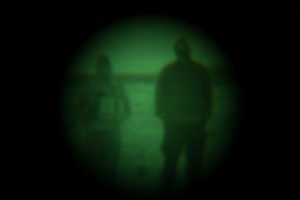
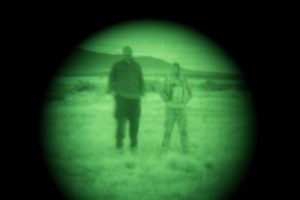
IR illumination helps when used close up or in enclosed, dark spaces. However neither of these photos was taken using IR. These photos were taken in starlight and the camera exposure was quite long but still representative of what is possible through these devices. The photos are not the best and we hope to update this post with better photos when the weather gets warmer. These were taken in the middle of the night in below freezing October temperatures. Getting the camera matched up to the device proved very difficult with numb fingers. To the naked eye and seen real-time the image would appear different, perhaps with a bit less brightness than depicted here but with proper eye relief the Sirius is very usable even though not as detailed or bright as the PVS-14.
The Monocular In Use…
This unit is easily mounted to a helmet with the appropriate mounts. Mounts can be found easily online. I was able to easily navigate with the unit head mounted on my MICH. The unit only weighs 1 lb but once mounted it feels quite cumbersome, and there’s more wobble in the helmet once it is installed.. Some helmet ballast might help with this.
The amplification is good and obstacles are easily seen in the wide field of view. When light conditions are too dark for this Gen 2 tube the IR works well and with it’s two settings, the user has options for preference. A few thing’s I noted while using this unit. While using it in dark urban conditions I was able to observe some joggers. From over 100 yards I could easily identify them as joggers in shadows with bright house lights behind them. Furthermore their MP3 players/phones glow. When I flipped the unit up my naked eyes could not see the glowing electronics, but I could with the Night Vision. Whatever it was on the devices was emitting invisible light that the Night Vision could detect and I could not.
In the near total darkness of starlight conditions the units performance suffered. It still out performed the Spartan, but it could not keep up with the nicer Gen 3 units we tested.
Bottom Line
This is a good Night Vision optic. It’s not the best, but it is useful for the tasks for which it was intended to be used. Navigation with this unit equipped is much more effective than with the Gen 1 device. Objects are more easily identified and it’s usable field of view is huge in comparison to the Gen 1 device. You can see a lot more and because you control the gain you can tune the amplification to your preference. The image has some distortion but it still quite usable.
This unit represents a usable unit at a more palatable price point that some of the higher end Gen 3 devices. it is heavier and more bulky than those devices, but the price point makes it accessible. While not equal to Gen 3 units, this unit offers a lot of value for the money. It is a quantum leap beyond the Spartan we previously reviewed. Gear is always a compromise, there are no perfect solutions, and quality costs money. This unit is no different, it’s cost represents a significant investment for most folks, but it’s performance is a clear step beyond toys and novelties.
Pros of the Armasight Sirius
- Good image quality
- Gen 2+ tube/light gathering
- Large Field of View
- Good Helmet mounting options/optic placement when head mounted.
Cons of the Armasight Sirius
- Some fish-eye
- Some Aliasing
- Suffers in low/no light conditions
- Heavy
Sirius Specifications
FLIR advertises the specifications for the Sirius ID MG as follows:

